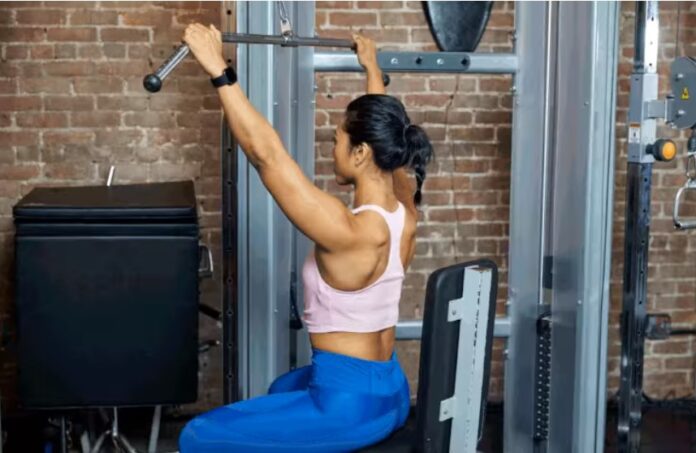The pulldown exercise, which is done at a workstation with adjustable resistance—typically plates—works the back muscles.
While seated, you pull a hanging bar toward you to reach chin level, then release it back up with control for one repetition. This exercise can be done as part of an upper-body strength workout How to Do a Lat Pulldown: Proper Form, Variations, and Common Mistakes.
How to Do a Lat Pulldown
Sit comfortably on the pulldown seat, with your feet flat on the floor. Check the height of the bar. You may need to adjust the bar height by shortening or lengthening the chain or cable that supports the bar or your seat height. Get a gym trainer to help with this if necessary How to Do a Lat Pulldown: Proper Form, Variations, and Common Mistakes.
The bar should be at a height that your outstretched arms can comfortably grasp the bar without having to stand up entirely, but you should also be able to still extend your arms to achieve a full range of motion. If there is a thigh pad at the station, make sure the upper thighs are securely tucked under it. You will benefit from this when you put effort into the bar.
- Grasp the bar with a wide grip with an overhand, knuckles-up grip. Other positions and grips are possible but start with this standard position.
- Pull the bar down until it’s approximately level with the chin. Exhale on the downward motion. While shifting slightly backward is OK, aim to keep your upper torso stationary. Keep your feet flat on the floor and engage your abs as you pull. The bottom of the motion should be where your elbows can’t move downward anymore without moving backward. Be sure to stop at that point and do not go lower.
- Squeeze the shoulder blades together while maintaining square shoulders.
- From the bottom position, with the bar close to your chin, slowly return the bar to the starting position while controlling its gradual ascent. Don’t let it crash into the weight plates.
- Continue until you complete eight to 12 repetitions in a set. Rest, then continue to complete your program of sets.How to Do a Lat Pulldown: Proper Form, Variations, and Common Mistakes
Benefits of Lat Pulldowns
It’s essential to target your back muscles to help with proper posture and to ease pulling movements, like opening a door, starting a lawnmower, swimming, or even performing a pull-up. Having strong lats may even help relieve some kinds of back pain.How to Do a Lat Pulldown: Proper Form, Variations, and Common Mistakes
Muscles Worked During Lat Pulldowns
This exercise mainly targets the latissimus dorsi, more commonly referred to as the “lats,” which is a muscle just under the armpits that spreads across and down the back. Lat pulldowns also work teres major, a muscle located near the bottom of the shoulder blade.How to Do a Lat Pulldown: Proper Form, Variations, and Common Mistakes
By isolating the back muscles with this exercise, you can focus specifically on them without tiring out the biceps or triceps.How to Do a Lat Pulldown: Proper Form, Variations, and Common Mistakes
Other Variations of Lat Pulldowns
You can perform this exercise in different ways to meet your skill level and goals.
Light Weights or Bands for Beginners
In order to make sure they use the proper form, beginners might wish to start with bands or small weights. Another option is to try the exercise while standing and putting one leg forward like you’re walking.
How to Do a Lat Pulldown: Proper Form, Variations, and Common Mistakes
Alternative Grips
Try wider, narrow, under- or overhand grips to target specific muscle groups. Using a middle-distance grip, with forearms upright and hands about shoulder-width apart, work the biceps and middle back. A wider grip recruits more back muscles, and a close grip pulldown emphasizes the forearm muscles.How to Do a Lat Pulldown: Proper Form, Variations, and Common Mistakes
Straight Arm Pulldown
The straight-arm pulldown, which requires keeping your elbows nearly fully extended the entire time (usually done standing), hits the muscles on the back of the upper arm, known as the triceps.How to Do a Lat Pulldown: Proper Form, Variations, and Common Mistakes
Reversing Your Grip
By switching to an underhand grip with the palms up and knuckles facing downward, you can strengthen your biceps, the muscles on the front of your upper arm.
You can reverse your grip in any position on the bar—wide, middle, or close.
Common Mistakes
Avoid these errors so you can get the most from this exercise and prevent strain or injury.
Arching Your Back
Sit upright and keep your chest lifted as you pull the bar down. Maintaining a neutral spine can help protect your lower back from injury.
Using Your Forearms
Be sure your forearms are not doing the work of pulling the bar down—you want it to come from your back. Activate your lats by pulling down from your armpits.
Holding the Bar Too Wide
Snatch the bar somewhat wider than shoulder width, especially if this is your first time. As you lower the bar, keep your elbows pointing down and not out to the sides.
Pulling Down Too Far
Stop at the point where your elbows would need to go backward to continue pulling the cable down. If the elbows go backward, it will put excessive stress on the shoulder joint. You should only lower the bar to your chin or just below.
Using Momentum
As with most weighted workouts, proceed with caution and cautiously when performing the pulldown. When done quickly, less of the targeted muscles are used and momentum is used.
Safety and Precautions
The pulldown behind the neck is not recommended for safety reasons, as the rotation of the shoulder joint and possible spine contact with the bar could lead to injuries.
If you have any wrist, elbow, or shoulder problems, talk to your doctor or physical therapist to see if this exercise is appropriate. Stop this exercise if you feel any pain or too much stress on your shoulder joints.
The number of reps you do in one workout will depend on the weight used, your experience level, and strength.

